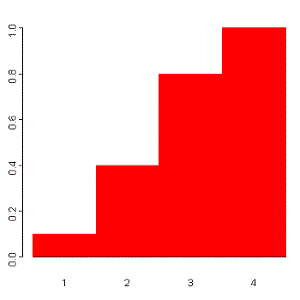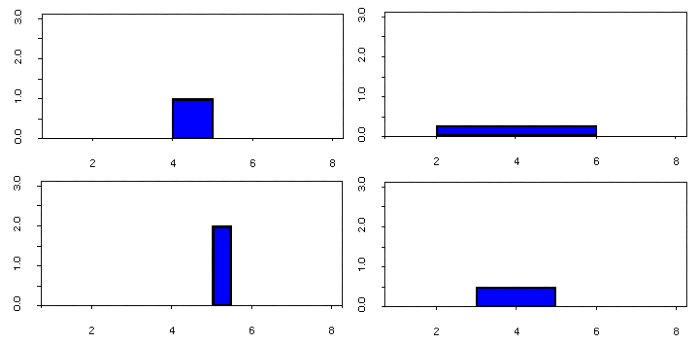Random Variables
A random variable, usually written X, is a variable whose possible
values are numerical outcomes of a random phenomenon. There are two types of random variables,
discrete and
continuous.
Discrete Random Variables
A discrete random variable is one which may take on only
a countable number of distinct values such as 0,1,2,3,4,........
Discrete random variables are usually (but not necessarily) counts.
If a random variable can take only a finite number of distinct values,
then it must be discrete. Examples of discrete random variables include
the number of children in a family, the Friday night attendance at a
cinema, the number of patients in a doctor's surgery, the number of
defective light bulbs in a box of ten.
The probability distribution of a discrete random variable
is a list of probabilities associated with each of its possible values.
It is also sometimes called the probability function or the probability
mass function.
(Definitions taken from Valerie J. Easton and John H. McColl's
Statistics Glossary v1.1)
Suppose a random variable X may take k different
values, with the probability that X = xi defined to be
P(X = xi) = pi. The probabilities
pi must satisfy the following:
- 1: 0 < pi < 1 for each i
- 2: p1 + p2 + ... + pk = 1.
Example
 Suppose a variable X can take the values 1, 2, 3, or 4.
Suppose a variable X can take the values 1, 2, 3, or 4.
The probabilities associated with each outcome are described by the
following table:
Outcome 1 2 3 4
Probability 0.1 0.3 0.4 0.2
The probability that X is equal to 2 or 3 is the sum of the two
probabilities: P(X = 2 or X = 3) = P(X = 2) + P(X = 3) =
0.3 + 0.4 = 0.7. Similarly, the probability that X is greater
than 1 is equal to 1 - P(X = 1) = 1 - 0.1 = 0.9, by
the complement rule.
This distribution may also be described by the probability
histogram shown to the right:
All random variables (discrete and continuous) have a cumulative
distribution function. It is a function giving the probability that
the random variable X is less than or equal to x, for
every value x.
For a discrete random variable, the cumulative distribution function
is found by summing up the probabilities.
(Definition taken from Valerie J. Easton and John H. McColl's
Statistics Glossary v1.1)
Example
 The cumulative distribution function for the above probability
distribution is calculated as follows:
The cumulative distribution function for the above probability
distribution is calculated as follows:
The probability that X is less than or equal to 1 is 0.1,
the probability that X is less than or equal to 2 is 0.1+0.3 = 0.4,
the probability that X is less than or equal to 3 is 0.1+0.3+0.4 = 0.8,
and
the probability that X is less than or equal to 4 is 0.1+0.3+0.4+0.2 = 1.
The probability histogram for the cumulative distribution of this
random variable is shown to the right:
Continuous Random Variables
A continuous random variable is one which takes an
infinite number of possible values. Continuous random variables are
usually measurements. Examples include height, weight, the amount of
sugar in an orange, the time required to run a mile.
(Definition taken from Valerie J. Easton and John H. McColl's
Statistics Glossary v1.1)
A continuous random variable is not defined at specific values. Instead,
it is defined over an interval of values, and is represented by
the area under a curve (in advanced mathematics, this is
known as an integral). The probability of observing any single
value is equal to 0, since the number of values which may be assumed
by the random variable is infinite.
Suppose a random variable X may take all values over an interval of
real numbers. Then the probability that X is in the
set of outcomes A, P(A), is defined to be the area above A and
under a curve. The curve, which represents a function p(x), must
satisfy the following:
- 1: The curve has no negative values (p(x) > 0 for all x)
- 2: The total area under the curve is equal to 1.
A curve meeting these requirements is known as a density curve.
The Uniform Distribution
A random number generator acting over an interval of numbers (a,b)
has a continuous distribution. Since any interval of numbers of equal width
has an equal probability of being observed, the curve describing the
distribution is a rectangle, with constant height across the interval
and 0 height elsewhere. Since the area under the curve must be equal to 1,
the length of the interval determines the height of the curve.
The following graphs plot the density curves for random number generators
over the intervals (4,5) (top left), (2,6) (top right), (5,5.5) (lower left),
and (3,5) (lower right). The distributions corresponding to these curves are
known as uniform distributions.
Consider the uniform random variable X defined on the interval (2,6). Since the interval
has width = 4, the curve has height = 0.25 over the interval and 0 elsewhere. The probability
that X is less than or equal to 5 is the area between 2 and 5, or (5-2)*0.25 = 0.75.
The probability that X is greater than 3 but less than 4 is the area between 3 and 4,
(4-3)*0.25 = 0.25. To find that probability that X is less than 3 or greater than
5, add the two probabilities:
P(X < 3 and X > 5) = P(X < 3) + P(X > 5) =
(3-2)*0.25 +
(6-5)*0.25 = 0.25 + 0.25 = 0.5.
The uniform distribution is often used to simulate data. Suppose you would like to simulate data
for 10 rolls of a regular 6-sided die. Using the MINITAB "RAND" command with the "UNIF" subcommand
generates 10 numbers in the interval (0,6):
MTB > RAND 10 c2;
SUBC> unif 0 6.
Assign the discrete random variable X to the values 1, 2, 3, 4, 5, or 6 as follows:
if 0<X<1, X=1
if 1<X<2, X=2
if 2<X<3, X=3
if 3<X<4, X=4
if 4<X<5, X=5
if X>5, X=6.
Use the generated MINITAB data to assign X to a value for each roll of the die:
Uniform Data X Value
4.53786 5
5.77474 6
3.69518 4
1.03929 2
4.23835 5
0.37096 1
0.75272 1
5.56563 6
0.89045 1
3.18086 4
Another type of continuous density curve is the normal distribution.
The area under the curve is not easy to calculate for a normal random variable X with
mean  and standard deviation
and standard deviation
 . However, tables (and computer functions) are
available for the standard random variable Z, which is
computed from X by subtracting
. However, tables (and computer functions) are
available for the standard random variable Z, which is
computed from X by subtracting  and dividing by
and dividing by
 .
All of the rules of probability apply to the normal distribution.
.
All of the rules of probability apply to the normal distribution.

 Suppose a variable X can take the values 1, 2, 3, or 4.
Suppose a variable X can take the values 1, 2, 3, or 4.
 The cumulative distribution function for the above probability
distribution is calculated as follows:
The cumulative distribution function for the above probability
distribution is calculated as follows: 